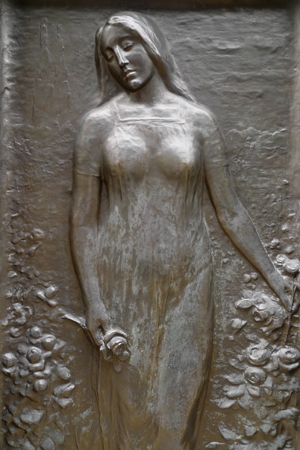
Documenting Recoleta Cemetery in Buenos Aires since 2007
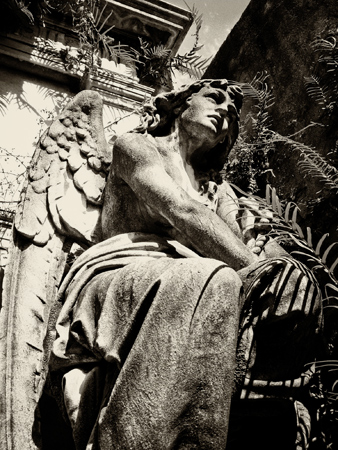
Jorge Luis Borges often wandered the walkways of Recoleta Cemetery (along with his friend & fellow writer Adolfo Bioy Casares), but his prediction of being buried there never came true. The cemetery, however, makes a remarkable appearance as the topic of one of his first published poems, La Recoleta… appearing in the 1923 collection Fervor de Buenos Aires. Below is the original text in Spanish followed by an English translation found online by Robert Mezey & Richard Barnes.
Convencidos de caducidad
por tantas nobles certidumbres del polvo,
nos demoramos y bajamos la voz
entre las lentas filas de panteones,
cuya retórica de sombra y de mármol
promete o prefigura la deseable
dignidad de haber muerto.
Made certain of impermanence
by so many noble witnesses of dust,
we linger with hushed voices
between the stately rows of mausoleums,
whose rhetoric of shade and marble
promises or foreshadows the appealing
dignity of having died.
Bellos son los sepulcros,
el desnudo latín y las trabadas fechas fatales,
la conjunción del mármol y de la flor
y las plazuelas con frescura de patio
y los muchos ayeres de a historia
hoy detenida y única.
Beautiful, these sepulchers,
the naked Latin and the linked and fatal dates,
flowers touching marble and
the little plazas cool and fresh as a courtyard,
the myriads yesterdays of a story
now cut short and unique.
Equivocamos esa paz con la muerte
y creemos anhelar nuestro fin
y anhelamos el sueño y la indiferencia.
Vibrante en las espadas y en la pasión
y dormida en la hiedra,
sólo la vida existe.
We confuse this peace with death
and we think we long for the end
when all we long for is indifference and sleep.
Vibrant in swords, tremulous in passion,
asleep in the ivy,
life is all there is.
El espacio y el tiempo son normas suyas,
son instrumentos mágicos del alma,
y cuando ésta se apague,
se apagarán con ella el espacio, el tiempo y la muerte,
como al cesar la luz
caduca el simulacro de los espejos
que ya la tarde fue apagando.
Time and space are but the forms it takes,
the magic instruments of the soul,
and when it is snuffed out,
as when the light dies
time & space will be snuffed out with it,
death will be snuffed out,
the semblance in the mirror expires,
which the twilight was already snuffing out.
Sombra benigna de los árboles,
viento con pájaros que sobre las ramas ondea,
alma que se dispersa entre otras almas,
fuera un milagro que alguna vez dejaran de ser,
milagro incomprensible,
aunque su imaginaria repetición
infame con horror nuestros días.
Kindly shade of trees,
bird-streaked wind that ripples through the branches,
soul dispersing itself into other souls,
it must have been a miracle that on a day those souls left off existing,
a miracle that passeth understanding,
even though its imagined repetition
stains our days with horror.
Estas cosas pensé en la Recoleta,
en el lugar de mi ceniza.
These thoughts came to me in La Recoleta,
in the place of my ashes.
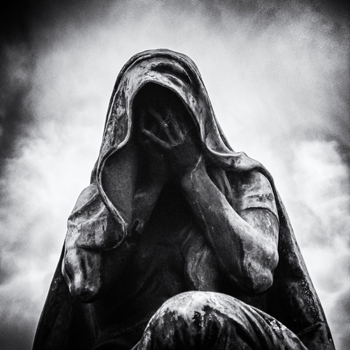
Photos courtesy of Marcelo Metayer.
Leave a Comment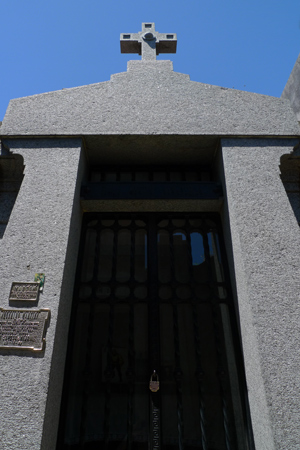
Born in Buenos Aires in 1922, Karadagián used his father’s heritage for a nickname in the professional wrestling world: the Armenian. After retiring from Greco-Roman wrestling, he switched to acting… playing a wrestler down on his luck in the 1957 film “Reencuentro con la gloria.”
These two worlds would come together when Karadagián began the tv show Titanes en el Ring in 1962. Similar to what Americans recognize as the World Wrestling Federation, Karadagián occasionally fought but often kept to the role of announcer. The show remained on the air until 1988, & Karadagián passed away a few years later in 1991.
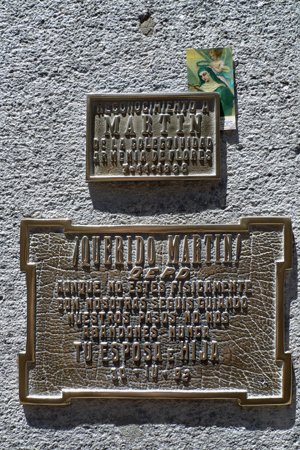
Although there is little to identify his tomb, two bronze plaques express sorrow at Karadagián’s departure. These type of plaques are more often found in Chacarita Cemetery, so they are even more endearing here. A peek inside shows the wrestler with his unmistakeable haircut:
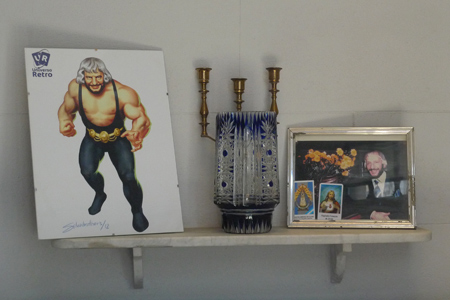
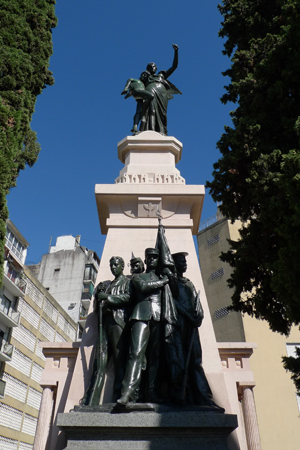
After becoming President in 1886, Miguel Juárez Celman began to distance himself from political supporters & preferred to do things his own way. Concentrating power in his own hands, the public referred to the term of Juárez Celman as a unicato… a one-man rule. After three years in office & with inflation out of control, diverse groups expressed their discontent with Juárez Celman. Upper class families, members of the clergy, university leaders, senators & the emerging middle class joined forces to form the Unión Cívica. Their main goal was to defeat the Juárez Celman in upcoming elections. But at the same time, preparations were being made for a coup d’etat.
Leading the Unión Cívica, Leandro Alem conspired with an influential general, Manuel Campos (brother of Luis María Campos). Planned for July 21st, the revolution was aborted by the arrest of key figures… someone had leaked information about the surprise attack. General Campos was taken under custody & while in prison received a visit by none other former President Roca. More sneaky plans were underway.
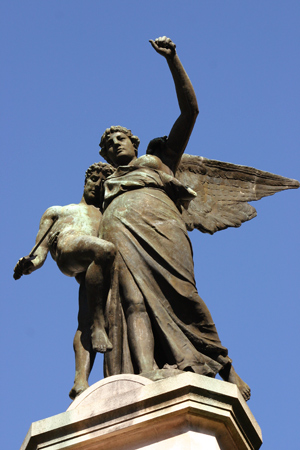
From his cell, Campos sent word to Alem to go ahead with their plans & fighting broke out early on 26 July 1890. Government forces used Retiro as their base of operations while Alem’s men were concentrated in Plaza Lavalle, now home of the Supreme Court.
As civilians rose up in arms to oust Juárez Celman, battles took place in the heart of Buenos Aires. Fighting continued sporadically for the next few days. General Campos made obvious military mistakes & gave the government ample time to recover & fight back. Alem noted these irregularities at the time but given the difficult situation, deferred to the general’s orders. Violence ended four days later with a truce. Estimates of those killed or wounded range from 300 to over 1,000. While the revolution was not successful in overthrowing the government, the political landscape quickly changed afterwards.
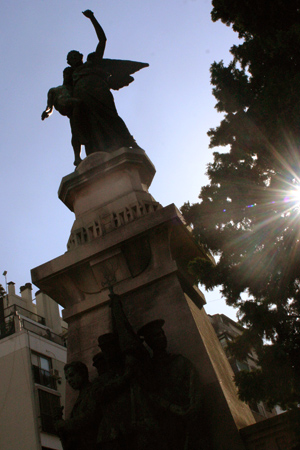
Juárez Celman lost support due to the conflict & resigned, handing the government to Vice-President Carlos Pellegrini. Although no historical record exists of conversations between Campos & Roca, it is taken for fact that Campos made bad tactical decisions on purpose. He threw the revolution so Roca & his elite allies could remain in power. The UC also had difficult times afterwards & split into two groups. One year later the Alem faction transformed into the UCR–Unión Cívica Radical. The UCR still plays an important role in politics as the main alternative to the Peronist party.
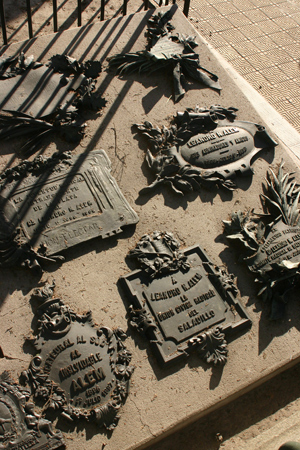
Numerous plaques cover the base of the entire pantheon, housing a few of the fallen during the revolution but many important figures from the UCR: party founder Leandro Alem, President Hipólito Yrigoyen (top casket with flag), & President Arturo Illia (silver casket). During the term of President Frondizi, this tomb was declared a National Historic Monument… even President Alfonsín spent a few months here until his own tomb was under construction.

All subplots & internal division aside, strong civilian support of the attempted revolution marked the beginning of civil society in Argentina & the birth of a radical political party. Every major figure on both sides of the Revolución de 1890 can be found somewhere in Recoleta Cemetery.
15 Comments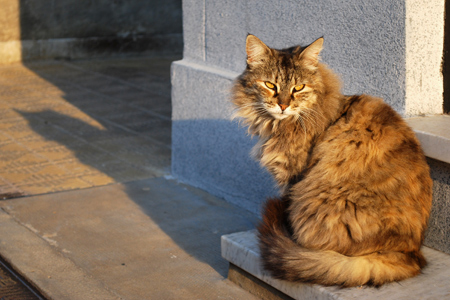
For a long time I’ve considered creating a space for contributions… photos of the cemetery I find interesting taken by someone other than Marcelo or me. Or perhaps highlight online galleries of Recoleta Cemetery. Not really sure what form it will take…
But here’s our first contribution. Romina Berardi is an interpreter & translator by occupation but also loves photography. Her equipment of choice is a Nikon D60, & I couldn’t resist her capture of a cat at sunset. Thanks for the contribution!
2 Comments